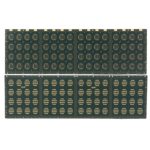Impedance control, the conductor in the circuit board will be a variety of signal transmission, to improve its transmission rate and must improve its frequency, the line itself, if due to etching, the thickness of the laminated layer, the width of the conductor and other factors that will cause impedance worth of change, so that the signal distortion. Therefore, the conductor in the high-speed circuit board, its impedance value should be controlled within a certain range, called “impedance control”.
The impedance of the PCB trace will be determined by its inductive and capacitive inductance, resistance, and conductivity. Factors that affect the impedance of PCB traces are copper line width, copper line thickness, dielectric constant of the dielectric, thickness of the dielectric, thickness of the pads, path of the ground, and alignment around the perimeter of the trace. PCB impedance ranges from 25 to 120 ohms.
In practice, a PCB transmission line usually consists of a wire trace, one or more reference layers, and insulating material. The trace and the layers constitute the control impedance. PCBs will often be constructed in multiple layers, and the control impedance can be constructed in a variety of ways. However, regardless of the method used, the impedance value will be determined by the However, whatever method is used, the impedance value will be determined by the physical structure and the electronic properties of the insulating material:
The width and thickness of the signal traces The height of the core or prefill material on either side of the trace The configuration of the traces and layers The insulation constants of the core and prefill material. …There are two main forms of PCB transmission lines: Microstrip and Stripline.
Characteristics of Impedance Control
Impedance control, hybrid force/position control, and explicit force control methods each have their unique characteristics when it comes to realizing force control. The force/position control method is based on dividing the coordinate space of the end-effector into position subspace and force subspace according to whether it is constrained by the environment or not. The force/position control method realizes compliance control by controlling the position of the end-effector in the position subspace and the force in the force subspace, and the advantage of this method is that it can directly control the interaction force between the end-effector and the environment, which is very important in some occasions. carrier control board
The disadvantage is that it requires a lot of task planning as well as the need to switch between force and position control. Impedance control, on the other hand, relies on regulating the dynamic relationship between the position of the end-effector and the contact force to achieve compliance control. This approach provides a unified method for collision avoidance, and constrained and unconstrained motion. The advantages are that it requires little offline task planning and is robust to perturbations and uncertainties. It can achieve a stable transition of the system from unconstrained to constrained motion. Therefore impedance control is considered more suitable for accomplishing assembly work. Its disadvantage is that in practice it is difficult to accurately obtain the reference trajectory of the end-effector and the position and stiffness of the environment. Thus neither position control nor force control can be realized accurately.
The comparison of impedance control with explicit force control demonstrates the equivalence of second-order impedance control and proportional explicit force control with feedforward in a rigid environment. It is shown that impedance control is a more general approach than explicit force control and that the main property of impedance control is to make the robot’s interaction with the environment independent of the objects in contact, whereas force control is susceptible to the influence of objects in contact.
Methods of implementing impedance control
In the early days of impedance control, fixed-gain PD control was used, which was simple to implement but could not maintain the desired impedance when the robot’s bit shape and velocity changed. Through the efforts of scholars, a variety of impedance control methods have been developed, and in general, there are two types of impedance control methods, one is the impedance control method based on the dynamics model. In general, there are two types of impedance control methods, one is the impedance control method based on the dynamics model, and the other is the impedance control method based on the position.
Contact us! carrier control board




